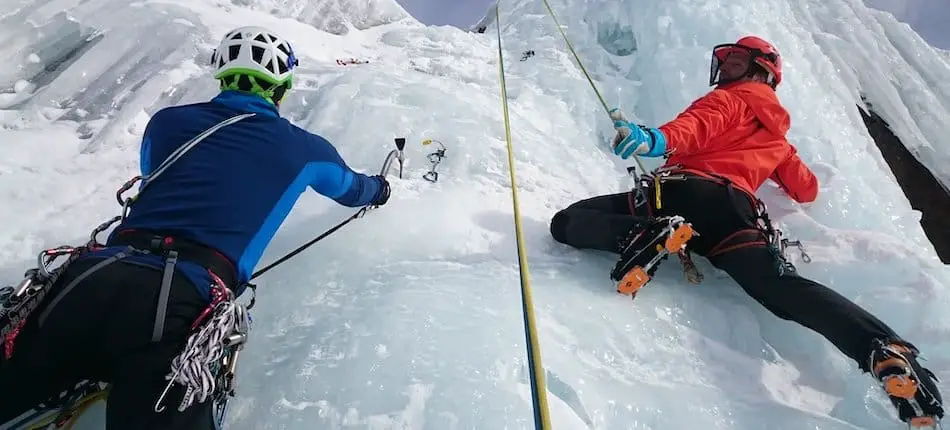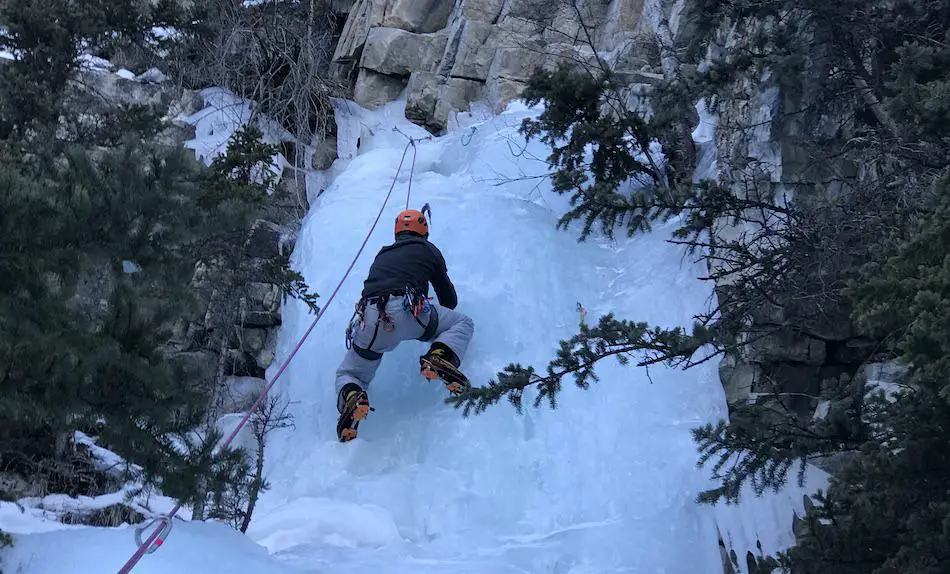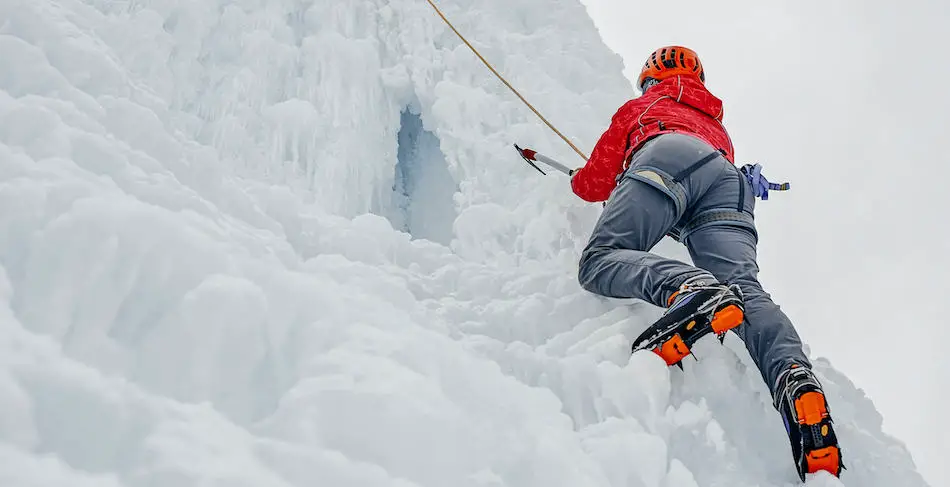
Your rope is one of the most important pieces of equipment you’ll choose for ice climbing. I’ve written the following guide to help you make that selection.
When ice climbing, you want a rope that’s dry treated and somewhere between 8.0mm-9.8mm thick. Half-rope systems are the most common, especially for long or multi-pitch climbs where rappelling is required.
There are a few things that you might do differently when you’re picking an ice climbing rope compared to a different activity (say, rock climbing). First and foremost is the type of rope system you use; while climbers almost exclusively use a single-rope setup, it’s more common in ice climbing to go with a double rope. Additionally, you want to make sure your rope is dry treated. In the following guide, I talk about what ropes to use, how to buy your ice climbing rope, and some personal recommendations.
What Rope Do You Use Ice Climbing?

First things first, let’s talk about what type of rope you want to use for ice climbing. Most climbing ropes will function just fine (as long as they’re dynamic), but that doesn’t mean that they’re going to be your first choice. For ice climbing, there are two main categories you need to consider:
- Dry treatment
- Your type of rope system (single, double, etc)
I talk about both categories in more detail below.
Dry Treated vs Non-Dry-Treated Ropes
Dry treatment is a process that helps prevent your rope from getting wet. To understand why this is important, you need to have a basic understanding of how climbing ropes are made. Dynamic ropes have two main components:
- The core, which is made of a stretchy nylon and is responsible for catching your weight when you fall.
- The sheath, which is designed to protect the core.
Essentially, the core does all of the important work of catching you when you fall, and the sheath protects the core from sharp rocks and anything else that would damage its structural integrity.
When the core of a rope gets wet, it loses a lot of its catching strength, and your safety is therefor compromised. To prevent this, some ropes are ‘dry treated’, meaning the sheath is designed to not let any water through.
Now, this dry treatment has limits as to how well it can perform. Especially with repeated use and exposure to the elements, the rope can lose some of its water proofing abilities.
Still, when ice climbing, you want to be sure to bring a dry treated rope. Throughout the day you’re going to be dragging it through snow and ice. It won’t be as bad as dumping the rope in water, but there’s bound to be a lot of exposure to moisture, and having the dry treatment can be good peace of mind.
So, my official recommendation: your ice climbing rope should be dry treated.
Single, Half, and Twin Ropes
Now it’s time to talk about the different rope systems and which ones you want to use. Before we get into it, I’m going to quickly define all three of them so that everyone’s on the same page:
Single Rope Systems

Your classic climbing setup. You tie into one rope, and you clip this rope through every piece of protection that you encounter. It’s easy to set up, simple to operate with, and you only have to carry one rope.
For this type of climbing, you’ll want a rope that’s somewhere in the 9mm-10.7mm range. Anything thinner won’t be strong enough to catch a fall by itself, while anything thicker might not fit through your belay devices.
Half Rope Systems
A half rope system is one of the hardest to use, but it can end up being one of the most versatile and handy techniques to have.
In a half rope system, you tie into two pieces of rope, each one around 8-9 millimeters thick. Both pieces of rope go through the belay device (so make sure you’re using something compatible like a Black Diamond ATC), and you climb as you normally would.
The thing about a half rope system is that you only need to clip one piece of rope through any given piece of protection. This can reduce the rope drag you have to contend with, especially if you’re on a route that winds around a fair bit: you can clip all of the leftwards protection to your left rope and clip all the rightwards ones with your right rope, which prevents you from having to zigzag around.
Half ropes have another advantage to them: when you get to the top, you now have two full-length pieces of rope that you can use to rappel. This allows you to use a two-strand rappel and do a 60-meter pitch in one rap, instead of needing to stop halfway down and set up another anchor. Doing so is impossible with a single-rope setup, unless you haul a tagline up the route with you.
Twin Rope Systems

Twin ropes are common in alpine and multipitch environments. They’re thinner than half ropes, usually coming in at around 7-8mm each, and the belay system to set them up is identical to that used in a half rope.
The difference between a half rope and a twin rope setup is that twin ropes are too thin to catch your fall by themselves. This means that you have to clip both pieces of rope through each piece of protection.
At first, this seems a little counter intuitive. If that’s the case, why do you even need to bother bringing both ropes? Couldn’t you just do a single rope system?
Using a twin rope setup, however, has some advantages to it:
- Longer rappels: Similar to the half rope, twin ropes allow you to do a full-length rappel, which is why it’s popular in the alpine and on multi pitch.
- Better weight distribution: In a team of two, each person can carry one half rope, instead of one person having to carry a full-length single rope.
Best Setup for Ice Climbing
So, now that we know what each rope system is, which one is best for ice climbing? Single or half rope systems are most commonly used for ice climbing.
If I had to pick one answer, I would say that a half rope system is the best one, for a few reasons:
- It allows you to reduce drag. Ice climbing can do a fair amount of zig zagging as you carve your way across a waterfall, trying to find the best ice and the most secure screw placements. Having a half rope setup allows you to minimize the rope drag.
- It’s better for rappelling: As mentioned, the dual rappels will help you, especially if you’re doing a multipitch or long single-pitch climb.
- You have double the security: One of the things to consider with ice climbing is that you have multiple sharp objects attached to your body at any given time. There’s also the chance of rock or icefall damaging one of your ropes (famous American alpinist John Harlin died when his rope was severed by a falling rock). By using half ropes, you always have a backup in case something happens to either of your lines.
That being said, the other two rope systems will work fine for most ice climbs. A twin rope system will still give you the security and rappel-ability that a half rope one will, and it can trim some weight if you have a particularly long approach to contend with.
For most single pitch climbs (e.g., cragging days where you’re not doing anything too adventurous), a single rope setup is going to be the simplest and easiest way to go. The routes will usually be short enough to lower from, and you won’t need to deal with the extra weight of carrying two ropes.
So, in summary: you always want to bring a dry treated rope with you when you’re ice climbing. For multi pitch, single pitches longer than thirty meters, or alpine environments, I would highly recommend using a half rope setup. For shorter single pitch climbs, a single rope should work.
How to Choose Your Ice Climbing Rope

Now that we know what rope you want to bring ice climbing, let’s talk about what you need to consider when buying your ice climbing rope. There are three areas that I’ve highlighted below that are worth knowing a little bit more about.
Price
Unfortunately, price is almost always a factor when you’re considering outdoor equipment. To buy a good dry-treated rope is probably going to cost you $225-$300, depending on which brand you go with.
Of course, the more money you pay, the higher quality you can expect your rope to be, although there tends to be a limit to this. For example, you should definitely spend a bit of extra money to get a good brand name (like Black Diamond, Petzl, or Sterling) and a nice dry-treated finish.
However, that doesn’t mean you need to buy the highest-end rope that you can find. We’re not all Tommy Caldwell trying to conquer the Fitz traverse; you don’t need to shed every possible ounce just to be able to go climbing.
Another thing to consider is the new versus used debate. I’ve said this before, and I’ll say it again: you should never buy a used rope. You have no idea what kind of condition it’s been stored in or what kind of damage has been done to it. Ropes save your life, and it’s always worth spending the money to buy a new one.
Size
The next big thing to consider is the size (or width) of the rope that you’re buying. Standard climbing sizes are as follows:
- Single ropes should be anywhere from 9mm-10.7mm
- Half ropes should be in the 8mm-9mm range
- Twin ropes can be as narrow as 7mm while still being effective
So, obviously, the width you want depends on what type of setup you’re using.
If you’re someone who ice climbs a lot, you might have two different systems: one to use for cragging, and one to use on multi-pitch routes. In this scenario, it can make sense to buy a smaller single rope (say a 9.2mm one), and then another half rope in the 8mm range. When you’re on longer routes, the single rope becomes part of your half rope system.
Length
Finally, you need to consider the length of your ropes. Personally, I wouldn’t recommend using anything less than a 60-meter rope. 70 is even better, and that extra ten meters can sometimes be the difference between not being able to do a route.
Obviously, longer ropes will cost more and will add extra weight to your pack, so there needs to be a balance. A lot of places sell 80 meter ropes, although these are less common (most routes will be set so that the anchors are compatible with a 70-meter rope.
Best Ice Climbing Ropes
Now that we know all about ice climbing ropes, let’s talk about some recommendations if you’re looking to buy:
Beal Iceline 8.1mm Half Rope
The Beal Iceline is maybe the best half-rope setup you can get for winter and alpine environments. It feels weird to use the word high tech to describe a rope, but the Iceline has just about every feature that’s available for climbing ropes:
- Unicore technology that binds the core and the sheath of the rope together, creating a more secure piece of equipment
- Dry Cover treatment on the sheath that rappels dust, water, and anything else that would compromise your core, while also increasing the handleability of the rope.
- Golden Dry core treatment in the core that resists water absorption and reduces weight gain if the rope does get wet
And, to top it all off, Beal plants a tree for every rope sold.
These ropes are sold at a pair and they cost $399 CDN for both of them, which is a really good deal for a pair of ropes. They’re 60 meters in length and weigh about 5 kilos (together, not 5kg each).
They might not be the lightest rope, and it would be nice to get them in a 70-meter length, but they’re high-quality pieces of equipment at a very affordable price.
Edelrid Skimmer 7.1mm
Edelrid has quickly been gaining more and more recognition within the North American climbing community for the high-quality gear they produce. This is shown once again in the Skimmer ropes, a pair of 7.1mm lines that actually meet all of the safety criteria to be used as a twin or half rope setup.
The idea that you can get a half rope for 2.5kg (half the weight of the Beal one) is insane in itself, but Edelrid went and made an incredible rope on top of that. The Skimmer has Pro-dry treatment and a thermal shield finish, both of which help the rope’s handling and durability.
The Skimmer does cost more, at $550 for the entire set. It may not be the best for beginners or recreational ice climbers, but for someone who’s looking to push the limits in the alpine, this rope is a solid choice.
Black Diamond 7.9mm Dry
A discount option that still packs some serious performance, the BD 7.9mm is another one that can be used as a half or twin rope in ice and alpine environments. The rope has a dry treated core and sheath, as well as a 2×2 sheath that’s specially woven to prevent abrasion.
Th best thing about this rope, however, is its price point. It costs about $280 for both ropes, which is an insane deal considering the performance you’re getting. If you’re looking for a more affordable option, I would seriously consider checking out Black Diamond.
